The Gates of Jerusalem | A Comprehensive Guide to Ancient Jerusalem

The Gates of Jerusalem
The gate to the city – Jaffa Gate
This is one of the city’s most magnificent and important gates and was the starting point of the road that led from Jerusalem to the port of Jaffa.
In the second half of the 19th century, the traffic of visitors and pilgrims to Jerusalem had increased dramatically, and Jaffa Gate was the main entrance into the Old City. Adjacent to the gate were stores and stalls, and the market that developed there welcomed visitors as they entered the city’s gates.
Alongside the gate was a stagecoach station, providing service between Jerusalem and Jaffa. The wall is pockmarked with bullet holes on either side of the gate, and above the archway, we can see a small cubicle, known as a “meshikuli” in Arabic, from the English “machicolation,” meaning a small balcony or turret that was used by the city’s defenders to observe those entering the city and if necessary – to pour boiling oil or tar on their enemies.
At the upper edge of the walls, we can see the crenelations that provided shelter for the fighters who stood on the walls. The gate itself is constructed with an “L” shaped defensive entryway that is typical for many of the Old City’s gates, which is aimed at making it more difficult for invaders to gain entry to the city.
The Jaffa Gate during the Festival of Light
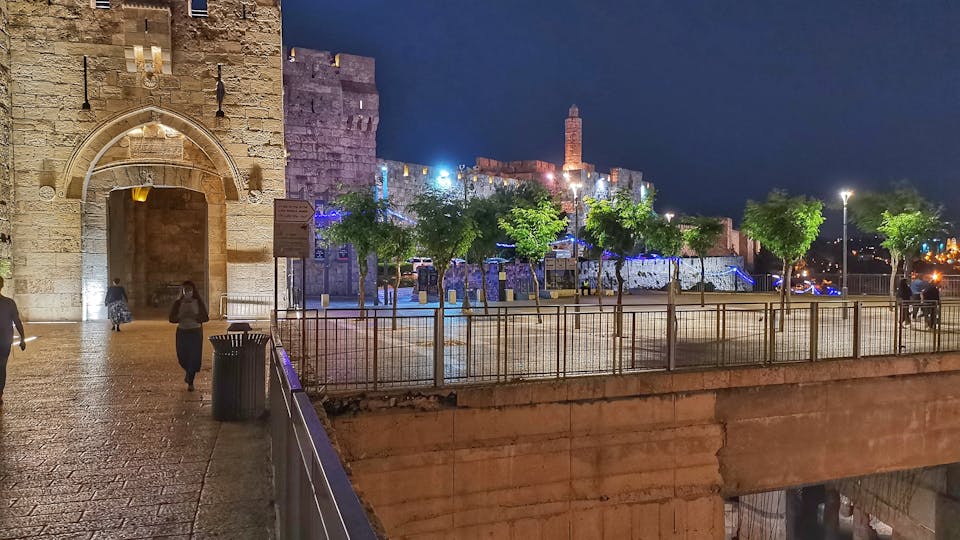
The Rampart Walk
From the observation platform above the gate, we see a tower with flags waving overhead. This is the Tower of David. The base of the tower was built about two thousand years ago, in the time of King Herod.
But during the Byzantine Period, the remains of the impressive tower was mistakenly identified with the period of King David, and the name remained. The tower later became part of a citadel built during the Middle Ages, and the entire complex is presently used by the Museum of the History of Jerusalem.
During the day, the Tower of David – Museum of the History of Jerusalem offers exhibits that follow the history of the city, taking visitors on a journey back in time. At night, there is an impressive sound and light show. In recent history, the Tower of David has become identified with the minaret of the citadel’s Ottoman mosque, which wasn’t built until the 17th century.
The road leading into the Old City was paved for the visit to Jerusalem by German Emperor Wilhelm II in 1989. The Emperor wished to enter Jerusalem astride his horse, as the Crusaders did when they conquered the city. To achieve this, the moat surrounding the citadel was filled in and a road leading into the Old City was paved in honor of the Emperor and his retinue.
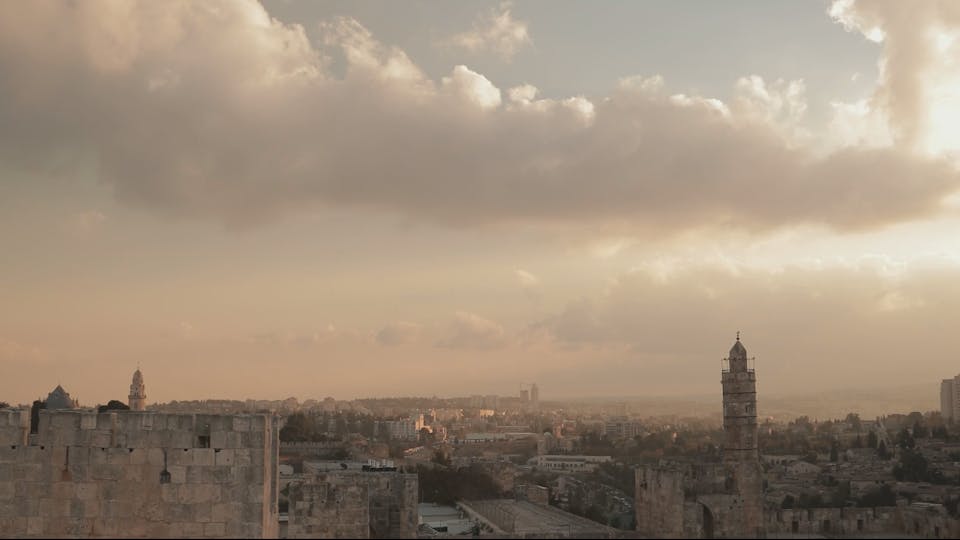
The city’s border – A view to the southwest
Looking towards the southwest we can see the red-tiled roofs of the Yemin Moshe Quarter, which was built in the 1890s and is named for Moses Montefiore.
Below these houses is the Hinnom Valley, and next to it lies Mishkenot Sha’ananim, the first neighborhood built outside the walls of the Old City in 1860. To the south of Yemin Moshe is St. Andrew’s Scottish Church and below that is the Begin Heritage Center, a building with white arches. At the top of the ridge, we can see the King David Hotel, built in 1931. The neighborhood of Mamila used to be located at the foot of the walls, but today it has been replaced by the Alrov – Mamila Avenue complex that includes residential, commercial, and tourism buildings.
From this vantage point, we can see and understand the complex reality created with the division of the city for 19 years, from the War of Independence in 1948 until the Six-Day War in 1967. The Old City and the walls surrounding it remained under Jordanian control, the area adjacent to the walls became a no man’s land, and beyond that was the Israeli section with its residential neighborhoods.
Yemin Moshe and Mamila are examples of neighborhoods that were close to the border and whose residents left with the War of Independence.
After that war, these neighborhoods were settled by new immigrants. They were in constant danger from Jordanian snipers who would threaten their peace and quiet from atop the walls.
Following the Six-Day War and the reunification of the city, these neighborhoods went from being frontier areas to the most sought after parts of the city. On the ruins of the Mamilla Quarter, we can see “David’s Village” with its white domes, and the Alrov – Mamila Avenue, into which some of the original buildings were integrated.
Beneath Yemin Moshe is the Hinnom Valley, mentioned in the Bible as the accursed site where ancient idolatrous Jews brought offerings to the god Molekh – by sacrificing their children. The prophets warned against these rites and forbade the Jewish people from taking part. The new Jerusalem Trail that was recently opened for hikers by the Nature and Parks Authority goes through the Hinnom Valley and you can walk along the trail and enjoy its plentiful trees and historical sites. The Hinnom Valley is also part of the “Walls Around Jerusalem” National Park.
Looking into the Old City from atop the walls we can see the houses, courtyards, and towers of the Christian Quarter. To the right is a prominent and impressive building with pointed gables and the white-and-gold flag of the Vatican flying overhead.
This is the Latin Patriarchate (Catholic), the seat of the Latin Patriarch. For hundreds of years following the fall of the Crusader Kingdom of Jerusalem there was no Latin Patriarch in the city. The Patriarchate was renewed in 1847, together with this high-level position in the Church hierarchy. In the past the Patriarch was European, but since 1987 the role of the Patriarch has been filled by someone of Arab descent.
Farther along is the School of the “Brothers” – College Des Freres, attended by Muslim and Christian pupils. When the city was divided basketballs from the school’s basketball court would fly over the walls into the no man’s land, to the pupils’ disappointment.
In December 1965 a UN representative asked the Israeli representative to the Armistice Committee to return the pupils’ lost balls – as a Christmas present. Israel agreed (among other things, for intelligence purposes) and at a jubilant ceremony, 28 balls from the no man’s land were returned to the pupils.
At the corner of the wall is an overlook towards the west. Opposite us is Jaffa Road and to the right, the building with the rounded façade is the historic Jerusalem Municipality building, which was constructed during the British Mandate.
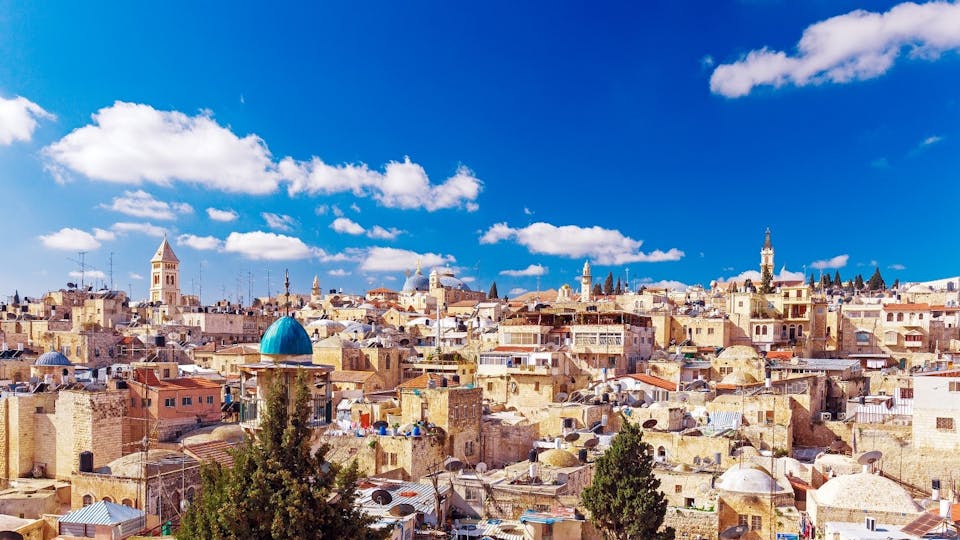
Breaking through the walls – The New Gate
During the last quarter of the 19th century, many Christian institutions were built to the west, outside the Old City walls. In order to facilitate movement between these buildings and the Christian Quarter, the New Gate was opened in 1889. Unlike the older gates, this one has no gatehouse and nor any special architectural elements.
Nearby we see the dome of the Qameriya Mosque. Outside the walls and across the street is a building built with classic symmetry and light blue shutters – this is the St. Louis French Hospital built at the end of the 19th century.
To the right of this at the bottom of the road is the French hospice, Notre Dame, with its two prominent towers, the statue of the Virgin Mary and the Vatican flag. The building was seriously damaged during the War of Independence, and after the war, it served as an Israeli military guard post.
To our right, we can see the entrance gate to the Franciscan compound, at the center of which is the St. Salvador Monastery (the Holy Savior) with its prominent clock tower. The Franciscan Order of Christianity was founded in the 13th century by St.
Francis of Assisi who preached simplicity, poverty, and performance of charity. Because of their tenacity in remaining in the Holy Land following the fall of the Crusader Kingdom of Jerusalem in 1187, the Franciscans were appointed by the Pope to serve as the custodians of the Holy Land (“Di Custodia Terra Sancta”) in the 14th century, to safeguard the interests of the Catholic Church in the east.
Roofs and towers along the skyline – View towards the northeast
Opposite we can see the red-tiled roofs of the Morasha (Musrara) neighborhood. East of this we see a bell tower with four turrets; this is St. George’s Anglican Cathedral. To the right of this, between the trees, is a building with a red roof and behind this is a splendid grey building. This is the St. Etienne Dominican Monastery.
In the background is the neighborhood of French Hill. To the right is Hadassah Hospital’s Mt. Scopus facility and the buildings of Hebrew University. The Mormon University building is a prominent sight on the slopes of Mt. Scopus, a splendid structure with numerous arches. To the right of this is the Augusta Victoria Hospital. On the peak of the Mount of Olives stands the bell tower of the Russian Orthodox Church of the Ascension.

Between Damascus and Nablus – Damascus Gate (Sha’ar Shechem)
From atop the Old City wall, we can see the Damascus Gate in all its glory. This is a major gate in the wall and it faces north towards Nablus (Shechem) and Damascus, which is where the gate gets its name in English. In Arabic the gate is called Bab al-Amud – the Gate of the Column – because of the large Roman victory column that once stood in the center of the gate’s plaza.
There are two towers on either side of the gate with turban-like machicolations at the corners from which nasty things could be poured down on those attacking the city.
Off to our right, we can see the golden Dome of the rock, and to the right of that is the darker dome of the Al-Aksa Mosque. From the square that looks out onto the Muslim Quarter, we can see the street leading from the Damascus Gate into the Muslim Quarter.
The street divides into two main thoroughfares that follow the course of the original Roman streets: The right-hand street is Khan a-Zayit Road – the Street of the Olive Press, and the left-hand street is Al-Wad Street – the Street of the Valley. Both of these are commercial roads that divide the cross the Old City from north to south.

The Roman Plaza and Zedekiah’s Cave
Underneath the Damascus Gate are impressive remains of the Roman victory gate and the gate’s plaza. There is also an exhibit on the history of the Damascus Gate. The entire eastern tower of the gate survived and was incorporated into the Ottoman Damascus Gate structure.
North of the Damascus Gate, underneath the walls, is a large and impressive artificial cave that was once an ancient quarry. It is 225 meters long and carved into the “meleke” limestone (from the Arabic word meaning “royal”) that was used during the time of Herod to build the Citadel, the king’s palace, and the Temple Mount.
Golgotha in the Garden Tomb
At the end of the 19th century Major-General Charles Gordon, a decorated British general, and hero of wars in Crimea, China, India, and Sudan, visited Jerusalem. As he observed the landscape from the balcony in the Old City he believed that he saw the shape of a skull in the rocky escarpment just outside the walls.
The general investigated and identified the site as the Golgotha Hill upon which Jesus was crucified, and the cave in which he was buried and from which he was resurrected. His identification of these sites was accepted among many Protestants, while other Christian sects identify Golgotha and the tomb of Jesus with the Church of the Holy Sepulcher. Around and near the site are other impressive burial caves dating from the First and Second Temple Periods.
The Garden Tomb is a site of worship for Protestant pilgrims and believers, and visitors to the site enjoy the beauty of the garden and its quiet atmosphere.
Rockefeller Archaeological Museum
The British Mandatory government searched for a building that could house the antiquities of the Holy Land. Thanks to a generous donation by the American Rockefeller Family, the museum was founded in 1938.
The building is an architectural wonder, designed by British architect Austen St. Barbe Harrison, who spent many months studying and designing the perfect place to house the antiquities of the Holy Land. The building integrates Jewish, Christian, and Islamic symbolism and numerous cultures from both east and west.
The building’s façade features a stone relief with two images representing the continents of Asia and Africa, where the ancient cultures began. The figures in the relief are bowing before the Tree of Life, which symbolizes the Holy Land, the cradle of civilization.
Today the Rockefeller Museum is part of the Israel Museum. It has permanent exhibits of antiquities from the Land of Israel discovered until 1948, including remains of an ancient man from caves in the Carmel Mountains, as well as statuary and jewelry from different archaeological excavations throughout the country.
The museum also has changing exhibits. The building is also the home of the offices of the Antiquities Authority and contains a huge archeological library.
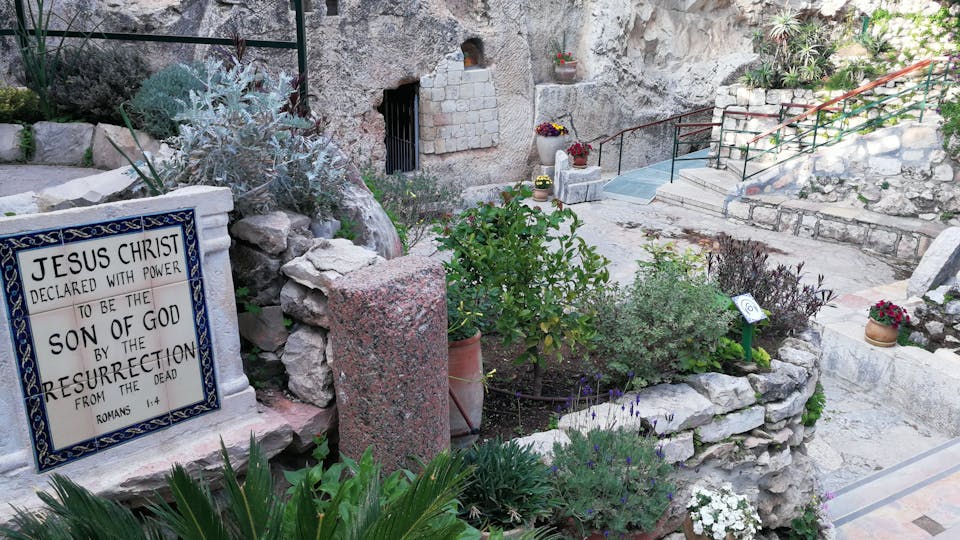
The Ramparts Walk from the Damascus Gate to the Lions Gate
As we continue to walk along the walls we see the impressive buildings and unfamiliar scenery that surrounds the Damascus Gate. Across from the Damascus Gate is the Roman Catholic St. Paul’s Hospice, a large and impressive building with its towers, arches, and domes that was built in the early 20th century.
Today it houses the Schmidt College. To the right is the East Jerusalem central bus station, and behind that is a quarry where First Temple Period tombs were found. This is also the hill where British explorer Charles Gordon found the Garden Tomb of Jesus.
From here we can also see the houses of the Sheikh Jarrah neighborhood, which were built during the second half of the 19th century when wealthy Muslim families left the Old City and built expensive homes near the Damascus Gate.
Flowers in the wall – Herod’s Gate / Flower Gate
Herod’s Gate or the Flower Gate was originally a small doorway in the wall that was closed most of the time. But due to construction by Muslims outside the walls, the present gate was opened in the Ottoman wall in 1875. The name of the gate has to do with a Muslim belief in the resurrection of the dead that will take place on the opposite hill, in the Muslim cemetery.
In the past, the gate was called Bab al-Sahira but over time the pronunciation was garbled and it became known as Bab al-Zahara, which means the Gate of the Flowers. There are those who claim that the rosettes carved into the stone near the gate are actually the origin of this name.
Farther along and to the left is a Muslim cemetery that extends southward over a vast area, part of an extensive burial ground used by the three monotheistic religions related to the Mt. of Olives and prophecies dealing with redemption and the end of days.
“The mountain on the east side of the city” – Overlook onto the Mount of Olives
From this point, we can observe the scenery of the Kidron Valley and the Mount of Olives, “the mountain on the east side of the city.” This ancient landscape is part of the “Walls Around Jerusalem” National Park that contains scenic, nature, and heritage sites.
On the slopes of the Mount of Olives is an ancient Jewish cemetery. At the top of the mountain is the Seven Arches Hotel.
The mountain also has numerous churches that commemorate various events and personalities associated with Christian tradition. To the left of the cemetery are the golden domes of the Church of St. Mary Magdalene, which was built by the Russian Orthodox Church at the end of the 19th century. At the foot of the Mount of Olives is the Church of All Nations at Gethsemane with its prominent cupolas and impressive mosaic.
Looking inside the Old City we can see the Temple Mount and the Church of St. Anne, named for the mother of the Virgin Mary and the grandmother of Jesus. The Bethesda Pool, once used to store water, was found in the nearby excavations.
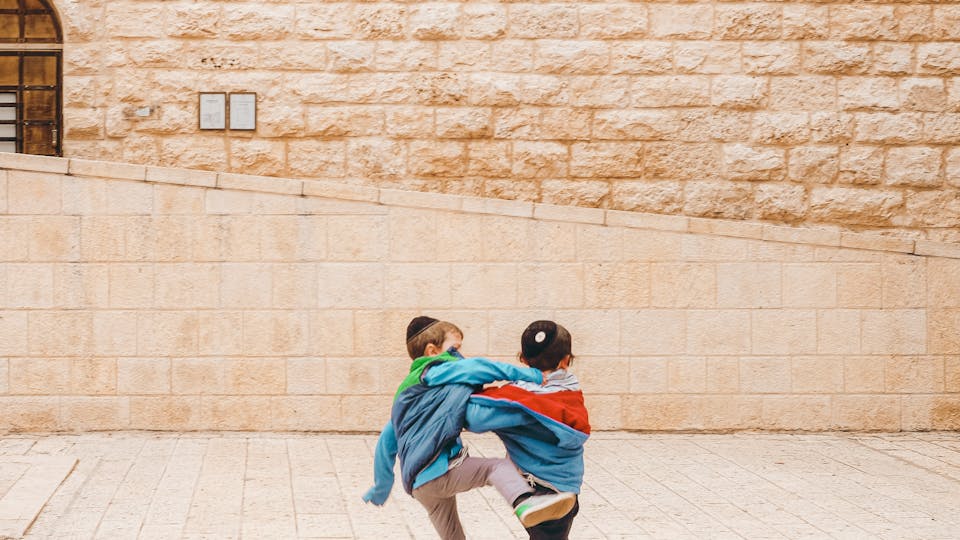
The sultan’s dream – the Lions Gate
A Jerusalem legend recounts how one night Sultan Suleiman the Magnificent had a horrible nightmare in which he saw lions threatening to devour him because he failed to properly protect the holy city of Jerusalem. The sultan immediately understood what he had to do, and hurried to surround the city with a wall, the very wall that encompasses the city to this day and on which we have just been walking.
The Lions Gate is the only gate that is open on the eastern side of the wall. In the wake of the Six-Day War, the name of the gate took on a new meaning due to the courage displayed by the IDF paratroopers as they broke through the gate on their way to the Old City and the Western Wall, reminiscent of the verse in the Tractate Avot: “Be strong as the leopard… and brave as the lion…” The origin of the name refers to the bas relief of a pair of carved lions flanking either side of the gate’s façade. There are those who believe that these are panthers, the crest of the Mameluke Emperor Baybars who ruled the Holy Land in the 13th century.
The Ottomans who defeated the Mamelukes and conquered the Holy Land from them included these reliefs in the wall they built around the city, which may have been taken from a more ancient building.
Jerusalem is truly an incredible place. We love taking our tourists there, and can't wait to have you back in Jerusalem!